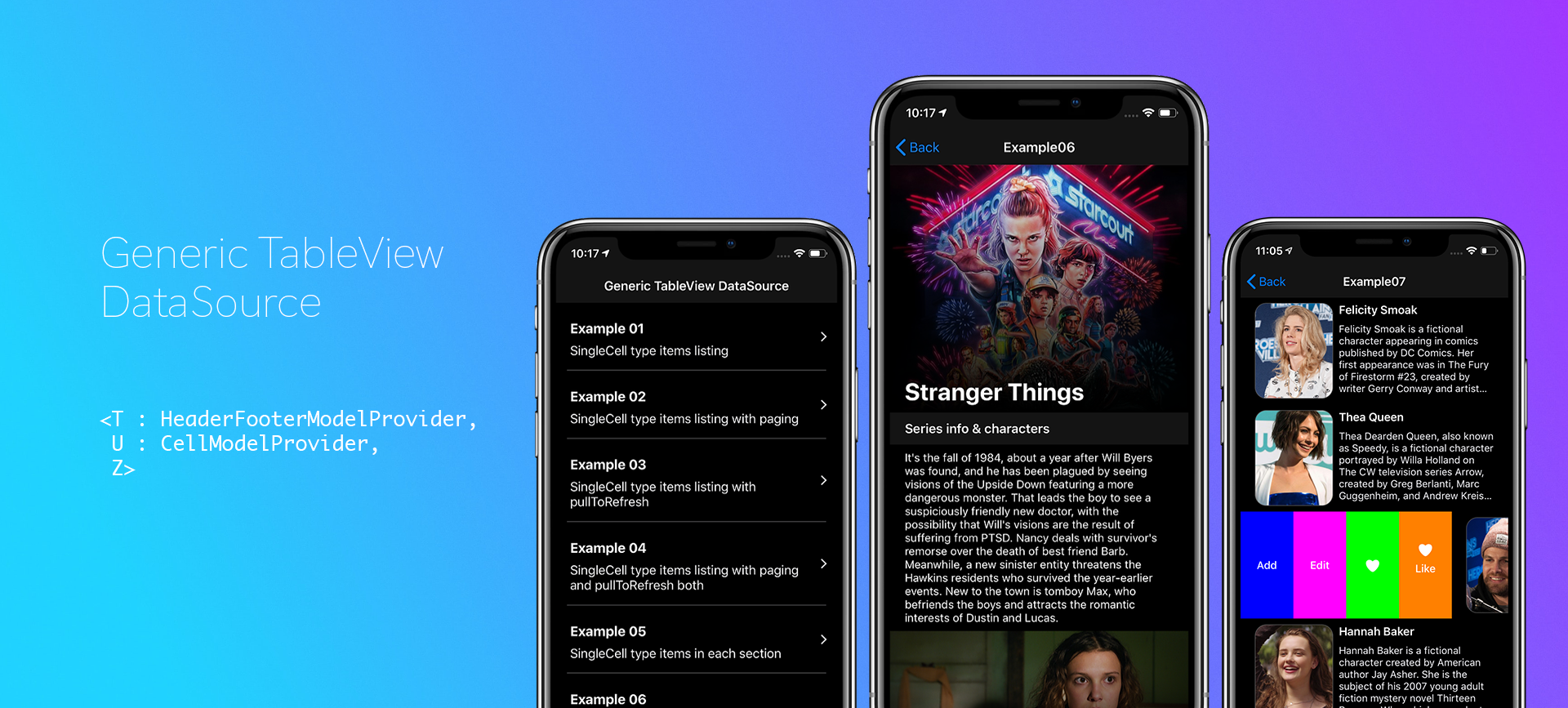
Features
- Single data source can be used to design simple to complex every type of vertical listing using tableview.
- Protocol oriented datasource with Generic models and associated types.
- Native pull to refresh functionality handled in datasource with UIRefreshControl.
- Infinite scrolling of tableview is also handled for paging.
Rules to follow if you’ve set your mind to use it.
- Every UITableView class should conform to ReusableCell protocol by inheriting it.
- Every UITableViewHeaderFooterView class should confirm to ReusableHeaderFooterView protocol by inheriting it.
- Your model class for setting data in UITableViewCell should confirm to CellModelProvider protocol by inherinting it.
#### CellModelProvider
protocol CellModelProvider { typealias Property = (identifier: String, height: CGFloat, model: CellModelType?) associatedtype CellModelType var property: Property? { get set } var leadingSwipeConfig: SKSwipeActionConfig? { get set } var trailingSwipeConfig: SKSwipeActionConfig? { get set } init(_ _property: Property?, _ _leadingSwipe: SKSwipeActionConfig?, _ _trailingSwipe: SKSwipeActionConfig?) } - Your model class for setting data in UITableViewHeaderFooterView should confirm to HeaderFooterModelProvider protocol by inheriting it.
#### HeaderFooterModelProvider
protocol HeaderFooterModelProvider { typealias HeaderProperty = (identifier: String?, height: CGFloat?, model: HeaderModelType?) typealias FooterProperty = (identifier: String?, height: CGFloat?, model: FooterModelType?) associatedtype CellModelType : CellModelProvider associatedtype HeaderModelType associatedtype FooterModelType var headerProperty: HeaderProperty? { get set } var footerProperty: FooterProperty? { get set } var items: [CellModelType]? { get set } init(_ _header: HeaderProperty?, _ _footer: FooterProperty?, _ _items: [CellModelType]?) }Code Examples
- For single listing with single cell types.
Consider you have following model.
class Example01Model { var name: String? var description: String? var imageName: String? init(_ _name: String?, _ _desc: String?, _ _imageName: String?) { name = _name description = _desc imageName = _imageName } }You can declare and instantiate tableViewDataSource instance like below.
private var items = [Example01Model]() private var dataSource: TableDataSource<DefaultHeaderFooterModel<Example01Model>, //Model Type for header footer conforming HeaderFooterModelProvider protocol DefaultCellModel<Example01Model>, //Model Type for cell confirming CellModelProvider protocol Example01Model>? //Model Type of data to be used in cell dataSource = TableDataSource<DefaultHeaderFooterModel<Example01Model>, DefaultCellModel<Example01Model>, Example01Model>.init(.SingleListing(items: items, identifier: Example01Cell.identfier, height: height), tableView)Setting data inside cell
class Example01Cell: UITableViewCell, ReusableCell { //Inheriting Reuasable Cell Protocol typealias T = DefaultCellModel<Example01Model> //Declaring type of model to be used @IBOutlet weak var imgView: UIImageView! @IBOutlet weak var lblTitle: UILabel! @IBOutlet weak var lblDesc: UILabel! var item: DefaultCellModel<Example01Model>? { // variable from which we can set data in cell didSet { imgView.layer.cornerRadius = 16.0 imgView.layer.borderColor = UIColor.darkGray.cgColor imgView.layer.borderWidth = 0.8 imgView.image = UIImage(named: item?.property?.model?.imageName ?? "") lblTitle.text = item?.property?.model?.name ?? "" lblDesc.text = item?.property?.model?.description ?? "" } } } - For multiple section and cell listing.
We need two models one for section footer and one for cell following rules that we’ve discussessed above.
class SeasonHeaderFooterModel: HeaderFooterModelProvider { //conforming HeaderFooterModelProvider protocol typealias CellModelType = ActorCellModel //cell model type typealias HeaderModelType = Season //header model type typealias FooterModelType = Any //Footer model type var headerProperty: (identifier: String?, height: CGFloat?, model: Season?)? var footerProperty: (identifier: String?, height: CGFloat?, model: Any?)? var items: [ActorCellModel]? required init(_ _header: (identifier: String?, height: CGFloat?, model: Season?)?, _ _footer: (identifier: String?, height: CGFloat?, model: Any?)?, _ _items: [ActorCellModel]?) { headerProperty = _header footerProperty = _footer items = _items } } class ActorCellModel: CellModelProvider { //confirming CellModelProvider protocol typealias CellModelType = Actor // model type of data to be used in cell var property: (identifier: String, height: CGFloat, model: Actor?)? required init(_ _property: (identifier: String, height: CGFloat, model: Actor?)?) { property = _property } }You can declare and instantiate tableViewDataSource instance like below.
private var items = [SeasonHeaderFooterModel]() private var dataSource: TableDataSource<SeasonHeaderFooterModel, ActorCellModel, Actor>? dataSource = TableDataSource<SeasonHeaderFooterModel, ActorCellModel, Actor>.init(.MultipleSection(items: items), tableView)Setting data inside header footer view
class TVSeriesHeaderView: UITableViewHeaderFooterView, ReusableHeaderFooter { typealias T = SeasonHeaderFooterModel // model type of data to be used in header footer view @IBOutlet weak var lblTitle: UILabel! var item: SeasonHeaderFooterModel? { didSet { lblTitle.text = item?.headerProperty?.model?.title ?? "" } } } - Table View Data source blocks can be used for further functionality.
dataSource?.configureHeaderFooter = { (section, item, view) in (view as? TVSeriesHeaderView)?.item = item } dataSource?.configureCell = { (cell, item, indexPath) in (cell as? Example01Cell)?.item = item } dataSource?.addPullToRefresh = { [weak self] in self?.pageNo = 0 self?.getNewDataWhenPulled() } dataSource?.addInfiniteScrolling = { [weak self] in self?.pageNo = (self?.pageNo ?? 0) + 1 self?.addMoreDataWithPaging() } dataSource?.scrollDirection = { (direction) in switch direction { case .Up: break case .Down: break } } dataSource?.didSelectRow = { (indexPath, item) in } - Leading and trailing swipe actions.
protocol CellModelProvider { typealias Property = (identifier: String, height: CGFloat, model: CellModelType?) associatedtype CellModelType var property: Property? { get set } var leadingSwipeConfig: SKSwipeActionConfig? { get set } // used to assign leading actions var trailingSwipeConfig: SKSwipeActionConfig? { get set } // used to assign trailing actions init(_ _property: Property?, _ _leadingSwipe: SKSwipeActionConfig?, _ _trailingSwipe: SKSwipeActionConfig?) } // Internal class handling all actions in datasource class SKSwipeActionConfig { private var actionValues: [(title: String?, image: UIImage?, backGroundColor: UIColor, identifier: String)]? private var swipeActionConfig: UISwipeActionsConfiguration? public var didSelectAction: ((_ identifer: String) -> Void)? init(_ _actions: [(title: String?, image: UIImage?, backGroundColor: UIColor, identifier: String)]) { actionValues = _actions var skActions = [UIContextualAction]() actionValues?.forEach({ (item) in let action = UIContextualAction(style: .normal, title: item.title, handler: { [weak self] (action, view, handler) in handler(true) self?.didSelectAction?(item.identifier) }) action.backgroundColor = item.backGroundColor action.image = item.image skActions.append(action) }) swipeActionConfig = UISwipeActionsConfiguration(actions: skActions) swipeActionConfig?.performsFirstActionWithFullSwipe = true } func getConfig() -> UISwipeActionsConfiguration? { return swipeActionConfig } }block that can be used to handle leading and trailing actions.
dataSource?.editActionForRow = { (indexPath, identifier, action) in switch action { case .Leading: print("Leading action tapped", "Identifer: \(identifier)") // do anything according to identifer if multiple actions case .Trailing: print("Trailing action tapped", "Identifer: \(identifier)") // do anything according to identifer if multiple actions } }